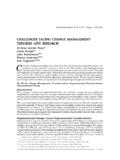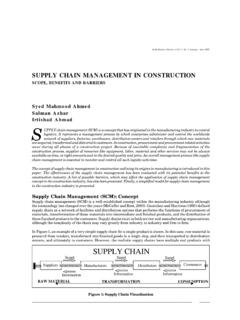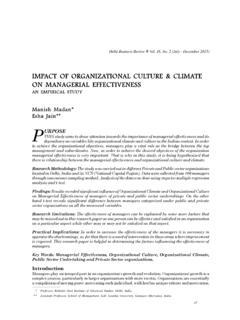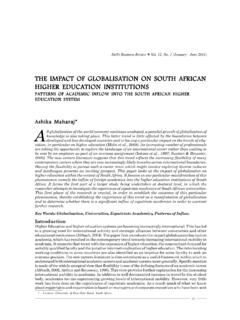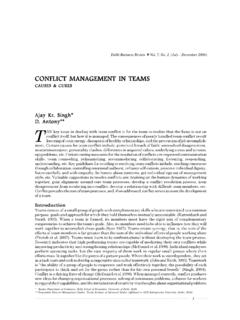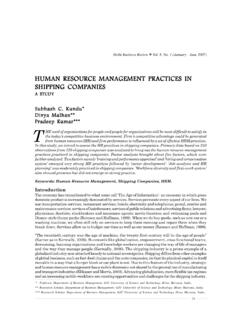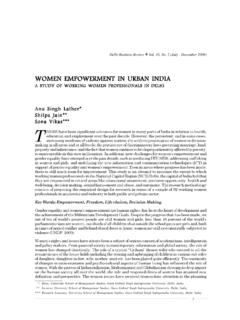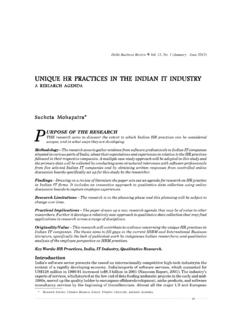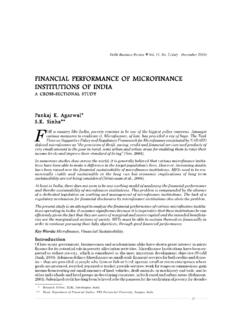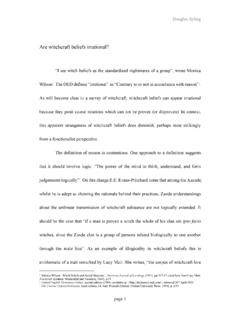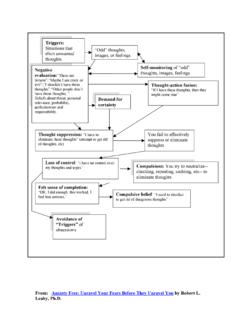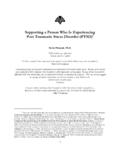Transcription of MANAGING CROSS-CULTURAL DIVERSITY
1 Delhi Business Review ? Vol. 2, No. 2, July - December 2001. MANAGING CROSS-CULTURAL DIVERSITY . A CHALLENGE FOR PRESENT AND FUTURE ORGANIZATIONS. Subhash C. Kundu I NTRODUCTION. The diverse workforce has become a reality today. The impact of cultural DIVERSITY varies with the type of environment and firm's overall strategy. As more and more number of firms move from domestic, multidomestic, multinational strategies to operating as a truly global firm, the significance and impact of cultural DIVERSITY increase markedly (Adler, 1997). Management of cultural differences has become more important for creating advantages and getting competitive edge. Diverse workforce ( DIVERSITY ) refers to the co-existence of people from various socio- cultural backgrounds within the company.
2 DIVERSITY includes cultural factors such as race, gender, age, colour, physical ability, ethnicity, etc. (Kundu and Turan, 1999). DIVERSITY includes all groups of people at all levels in the company. DIVERSITY requires a type of organizational culture in which each employee can pursue his or her career aspirations without being inhibited by gender, race, nationality, religion, or other factors that are irrelevant to performance (Bryan, 1999). MANAGING DIVERSITY means enabling diverse workforce to perform its full potential in an equitable work environment where no one group has an advantage or disadvantage (Torres and Bruxelles, 1992). Dynamic companies look for people who are different from us because the diverse workforce may bring different talents, interests, and viewpoints (Simmons, 1996).
3 The organizations which fail to embrace DIVERSITY effectively and do not take a holistic approach to eliminate discrimination and injustice will adversely affect both employees and customers. Organizations must concentrate on holistic strategies that address broader human resource issues, and value diverse employees. Companies must also consider stakeholders as employees. The viewpoints of stakeholders such as shareholders, suppliers, public agencies, and government regulators should be considered in shaping the culture of performance and approaching the diverse markets. Customers/clients are partial employees of service organizations (Mills and Morris, 1986) and directly involved in the service production function (Mills, chase and Margulies, 1983).
4 In number of situations employees, customers and other stakeholders in the service environment interact to produce the ultimate service outcome (Zeithaml and Bitner, 1996). The service company managers should have diverse managerial strategies to manage both their full-time employees and partial employees those are customers (Govender, 1999). A type of organization should be created where diverse body of employees, customers and stakeholders are valued and integrated into all dimensions of the work. Companies must learn from the people they serve. Employees can get their best product and service ideas by listening to, intently and regularly, the outside constituencies (Peters and Waterman, 1994). Subhash C. Kundu To solve the problem of unfair, inequitable treatment of diverse people, both as employees and customers, managers must recognize that such treatment is bound with bureaucratic structure, subjectivity and irrationality, inappropriate policies and practices, ineffective implementation of human resources and customer retention policies and practices, and inefficient and ineffective managers (Fernandez, 1998).
5 In this manner, companies can create constituent capitalized workforce by establishing mutual trust and respect among employees, customers and stakeholders (Fernandez, 1998). Companies should completely reshape the working culture that make possible the integration of a broad range of viewpoints that leads to a redefinition of how work gets done and how diverse markets are approached and capitalized upon. All employees should be held accountable for their behaviours and human resources results. Companies must create a post bureaucratic organization based upon trust and respect in which diverse employees are valued and integrated into all aspects of the work. Companies should rethink and redefine missions, strategies, management practices, cultures, markets, and products to meet the needs of an increasingly diverse body of employees, customers and stakeholders (Fernandez, 1998).
6 There are certain arguments for creating a diverse workforce, those are as follows: (i) As the number of women, minorities etc. in the workforce increase, so will their influence as consumers. Hiring women, minorities, disabled, etc. will help the organizations to tap these niche markets (Mueller, 1998). (ii) As all the segments of society have stake in the development and prosperity of the society as a whole, the creation of diverse workforce should be seen as a social and moral imperative. (iii) DIVERSITY enhances creativity and innovation and produces advantages. (iv) DIVERSITY helps organizations for entering the international arena. (v) Diverse teams make it possible to enhance flexibility and rapid response to change. DIVERSITY also causes certain problems those are as follows: (i) Communication becomes more difficult.
7 Employees from different cultures fail to understand one another. Firms operating in different language areas find difficulty in communicating with the local employees as local employees speak different language. (ii) DIVERSITY increases ambiguity, complexity and confusion. (iii) DIVERSITY also causes problems when managers and employees overgeneralize organizational policies, strategies, practices and procedures. (iv) cultural DIVERSITY creates difficulties for an organization when it wants to reach on a single agreement. (v) cultural DIVERSITY increases the complexity and problems in developing overall organizational procedures. A company with a diverse workforce can better serve and compete in diverse markets. Hiring a diverse workforce can be challenging but the greater challenge is to retain the diverse workforce.
8 Delhi Business Review ? Vol. 2, No. 2, July - December 2001. Exploring best HR practices helps in indentifing the best tools for retaining a diverse workforce. These practices include establishing open communication, supporting ongoing training and mentoring programmes and linking pay to DIVERSITY goals. Ultimately, the key to create, develop, and retain diverse workforce is to find a way to make workforce to feel connected to their company (Farren and Nelson, 1999). cultural DIVERSITY and Management The cultural impact on management is reflected by basic values, attitudes, beliefs and behaviour of the people. Culture can affect technology transfer, managerial attitudes, managerial ideology and even government-business relationships.
9 Moreover culture affects how people think and behave (Hodgetts and Luthans, 1994). In some societies important decisions are made by few top managers, while in others, these decisions are diffused throughout the enterprise. American society comes under the first case and Japanese comes under the latter case. American and other Western countries' cultural norms require individual rewards that are not so in Japanese culture. In some societies, risk-taking is encouraged which is not so in others. People identify themselves very strongly with their company as in Japan against America where people identify themselves with their occupational group. Some societies encourage cooperation between people. Others encourage competition between people.
10 Some countries believe in short-term goals, while others are more interested in long-term goals. Western countries put high value on innovation and change as against rest of the countries where stability is being encouraged. So, it is the cultural background that creates differences (Reynolds, 1986). Dimensions of Difference Differences in work-related attitudes exist across a wide range of cultures (Adler, 1997). Geert Hofstede (1980), an eminent Dutch management researcher, conducted a big survey of 1,60,000. managers and employees working for an American multinational corporation (IBM) covering 40. countries initially, which was later expanded to over 70 countries around the world (Adler, 1997;. Hodgetts and Luthans, 1994).

